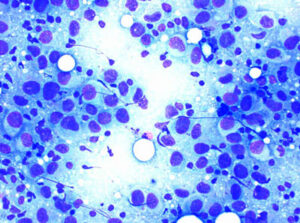Fine-needle aspiration is a method of collecting cells from the breast, liver, mouth, neck, lymph nodes, genitals, respiratory tract, or thyroid to look for signs of cancer, infection, or other conditions. A health professional inserts a thin needle into a lump and withdraws a sample of cells or fluid. The material is then examined under a microscope.
Fine-needle aspiration may be the only test you need to find out whether a lump is cancerous; however, in some cases you may have another procedure, such as a core needle biopsy or an open biopsy. In a core needle biopsy, you will have local anaesthetic to numb the area. The doctor places the core needle-which is larger than the needle used in an aspiration-into the lump. Then he or she takes out a thin section of tissue, rather than a few cells. In an open biopsy, a doctor uses a surgical knife to remove a sample of tissue. An open biopsy may be done in the operating room, with or without a general anaesthetic..

